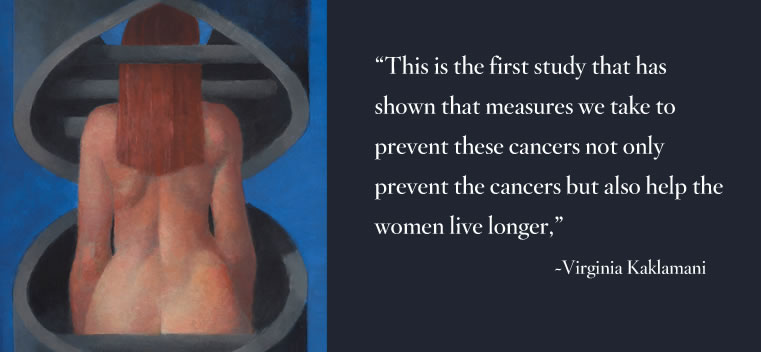
Standing Up to Breast Cancer
Nearly 10 years ago Joanna Rudnick (WCAS96) learned that she carries a potentially deadly genetic mutation that greatly increases her risk for breast and ovarian cancer. Women who inherit a BRCA1 or BRCA2 gene mutation have up to an 84 percent lifetime risk of breast cancer and up to a 63 percent risk of ovarian cancer.
Rudnick, a filmmaker, decided to document her struggle to live with the specter of cancer, including her own uncertainty about whether or not to have preventive surgery (see “In the Family,” fall 2008). She says the conversation about breast cancer risk and the options for preventive treatment has changed dramatically since she began to document her story with Kartemquin Films six years ago, leading to her Emmy-nominated film In the Family, released on PBS in 2008. “We are thankfully living in a more open time,” she says.
Dina Roth Port (J97) is contributing to the conversation. In Previvors: Facing the Breast Cancer Gene and Making Life-Changing Decisions, Roth Port chronicles the experiences of five women from her South Florida community who had preventive surgeries to reduce their breast cancer risk after learning they had significant odds of getting the disease.
The book, which came out in October, is one of the first comprehensive guidebooks for women facing the life-changing choices that come with an increased risk for breast cancer.
Roth Port, a former health editor for Glamour and Parenting magazines and now a freelance journalist, says women should know their family history of cancer and talk to a genetics expert about whether or not they should consider genetic testing. For women who carry a BRCA gene mutation or another significant risk factor, protective options include lifestyle changes, increased surveillance or chemotherapy prevention. The option that most dramatically lowers breast cancer risk is prophylactic mastectomy, which removes healthy breast tissue. Women with a BRCA mutation also have a high risk for ovarian cancer, and they might want to also consider the surgical removal of their healthy ovaries and fallopian tubes.
A large observational study published in the September Journal of the American Medical Association showed women with a BRCA gene mutation nearly eliminate their risk for breast and ovarian cancer by having the prophylactic surgeries.
“This is the first study that has shown that measures we take to prevent these cancers not only prevent the cancers but also help the women live longer,” says Virginia Kaklamani (G03, GFSM03), an associate professor of hematology and oncology at Northwestern. She co-wrote an editorial, which appeared with the JAMA study, about the importance of genetic testing for women with a family history of breast or ovarian cancer.
Kaklamani, co-director of the Cancer Genetics Program at the Robert H. Lurie Comprehensive Cancer Center of Northwestern University, is one of 70 breast cancer experts Roth Port interviewed for her book. Kaklamani is also the second Lynn Sage Scholar. Five years ago Laura and Halee Sage launched the Lynn Sage Foundation in honor of their mother. Laura (KSM98) and Halee (SESP95) were 13 and 11, respectively, when they watched Lynn succumb to breast cancer in 1984.
The foundation supports one Lynn Sage Scholar at the Lurie Cancer Center every year with a $100,000 grant. Kaklamani is using the funds to examine the connection between obesity and breast cancer. Women who gain weight after the diagnosis tend to have a worse prognosis.
Rudnick also has a new study in the works. Along with the Center for Medical Genetics at the NorthShore University HealthSystem and the University of Chicago’s Center for Clinical Cancer Genetics, she’s applying for a National Institutes of Health grant to study the use of In the Family as a decision aid for women undergoing the genetic counseling and testing process.
And in her personal battle to eliminate the risk of cancer, Rudnick has made some tough decisions. While she continues a regimen of surveillance, Rudnick, who married in October, has decided to have the risk-reducing surgeries after having a family with her new husband, Jordan.
“We’re living in a time when we have this unbelievable knowledge of our future cancer risk, but the only option for preventing disease is removing body parts,” she says. “But at least we have this option, and I’ve come around to knowing this is the safest path for me in terms of living a healthy life.”



 Facebook
Facebook Twitter
Twitter Email
Email


